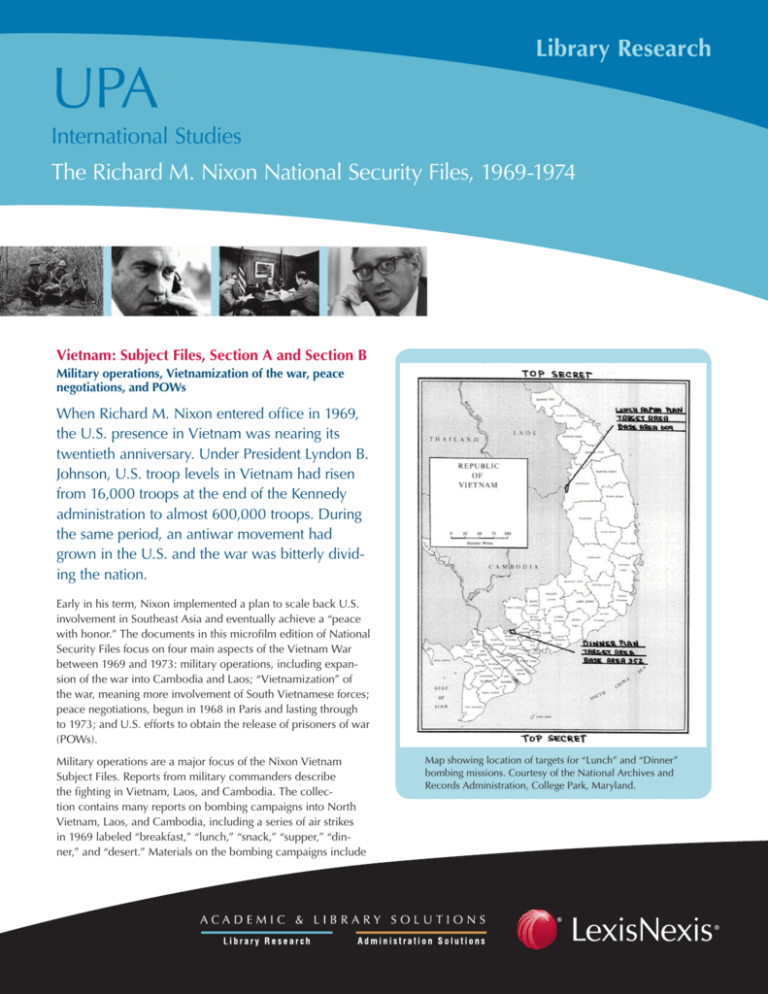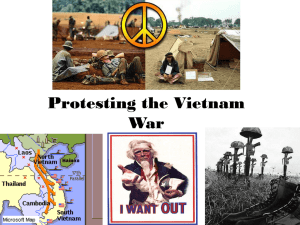
UPA
Library Research
International Studies
The Richard M. Nixon National Security Files, 1969-1974
Vietnam: Subject Files, Section A and Section B
Military operations, Vietnamization of the war, peace
negotiations, and POWs
When Richard M. Nixon entered office in 1969,
the U.S. presence in Vietnam was nearing its
twentieth anniversary. Under President Lyndon B.
Johnson, U.S. troop levels in Vietnam had risen
from 16,000 troops at the end of the Kennedy
administration to almost 600,000 troops. During
the same period, an antiwar movement had
grown in the U.S. and the war was bitterly dividing the nation.
Early in his term, Nixon implemented a plan to scale back U.S.
involvement in Southeast Asia and eventually achieve a “peace
with honor.” The documents in this microfilm edition of National
Security Files focus on four main aspects of the Vietnam War
between 1969 and 1973: military operations, including expansion of the war into Cambodia and Laos; “Vietnamization” of
the war, meaning more involvement of South Vietnamese forces;
peace negotiations, begun in 1968 in Paris and lasting through
to 1973; and U.S. efforts to obtain the release of prisoners of war
(POWs).
Military operations are a major focus of the Nixon Vietnam
Subject Files. Reports from military commanders describe
the fighting in Vietnam, Laos, and Cambodia. The collection contains many reports on bombing campaigns into North
Vietnam, Laos, and Cambodia, including a series of air strikes
in 1969 labeled “breakfast,” “lunch,” “snack,” “supper,” “dinner,” and “desert.” Materials on the bombing campaigns include
Map showing location of targets for “Lunch” and “Dinner”
bombing missions. Courtesy of the National Archives and
Records Administration, College Park, Maryland.
Library Research
descriptions of the plans, maps of the target areas, and photos
taken after the bombs were dropped. There are also numerous
reports on land battles, such as the battle for Hill 937, known as
Hamburger Hill.
One of the Nixon administration’s main strategies for decreasing
U.S. involvement in Vietnam was the plan for Vietnamization of
the war. This meant training South Vietnamese soldiers so that
they could assume more of the burden of prosecuting the war.
Nixon then hoped to start bringing U.S. troops home. Nixon first
announced the Vietnamization policy in a speech on November
3, 1969. In this speech, he appealed to the “great silent majority”
of Americans to stand with him as he sought peace in Vietnam.
The files contain several drafts of this speech and other Nixon
speeches, as well as public and international reaction to the
speeches. The documents on the Vietnamization of the war
include many memoranda from Henry Kissinger, then Assistant
to the President for National Security Affairs, revealing Kissinger’s
close involvement in Vietnam policymaking. A report from 1971
by Secretary of Defense Melvin Laird commented favorably
on Nixon’s policies, and reported that “South Vietnam’s armed
forces have improved and continue to improve.” Laird noted that
the U.S. troop presence had declined from 621,000 in July 1969
to 394,900 in December 1970.
In addition to these four major topics, other documents cover
the court-martial of Lieutenant William Calley, commander of the
company that committed the My Lai massacre in March 1968;
White House reaction to the New York Times publication of the
Pentagon Papers; and the activities of the Citizens Committee for
Peace with Freedom in Vietnam, a group that supported Nixon’s
Vietnam policies.
This edition will allow researchers to see the war as it played
out on the ground in Vietnam, in the White House, and at the
negotiating table in Paris.
While Laird could report favorably on the military situation in
1971, another facet of Nixon’s Vietnam policy was not progressing as quickly. During 1968, the U.S. and North Vietnam began
peace talks in Paris. It would take more than four years, however,
before the two sides finally signed a peace agreement in 1973.
This edition contains thousands of pages on the peace talks.
One of the issues that complicated the peace talks was the
release of U.S. POWs held in North Vietnam and North
Vietnamese POWs held in South Vietnam. In December 1969,
Nixon stated that any satisfactory settlement to the war had
to include the release of American POWs. A Department of
Defense paper from July 1970, however, warned that the more
emphasis the administration placed on POWs, “the greater the
price the other side can successfully demand for their return.” In
November 1970, the U.S. launched “Operation King Pin,” a raid
into North Vietnam in an attempt to rescue about sixty American
POWs. While the raid failed to free any prisoners, families of
the POWs reacted favorably to the attempt. Other materials on
POWs include reports on the efforts of Ross Perot, then president
and board chairman of Electronic Data Systems Corporation, to
deliver medical supplies and mail to American POWs.
For more information,
contact your sales representative or visit
www.lexisnexis.com/academic
Cover page of U.S. Information Agency report on international reaction to Nixon’s November 3, 1969 speech. Courtesy of the National
Archives and Records Administration, College Park, Maryland.
The Richard M. Nixon National Security Files, 1969-1974
Vietnam: Subject Files, Section A and Section B
Section A: PIN 0000102565; 22 reels
Section B: PIN 0000102567; 20 reels
Source Note: National Archives, College Park, Maryland,
Nixon Presidential Materials, National Security Council
Files, Vietnam Subject File.
LexisNexis, the Knowledge Burst logo, and Nexis are registered trademarks of Reed Elsevier
Properties Inc., used under license. © 2006 LexisNexis, a division of Reed Elsevier Inc. All
rights reserved.
PIN 102565/102567









![vietnam[1].](http://s2.studylib.net/store/data/005329784_1-42b2e9fc4f7c73463c31fd4de82c4fa3-300x300.png)